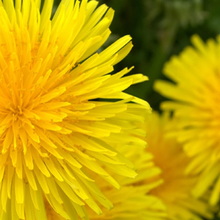(Editor's Note: This article was originally published on June 9, 2008. Your comments are welcome, but please be aware that authors of previously published articles may not be able to promptly respond to new questions or comments.)
"For those who have troubles, for those who are unhappy, for those who have received bad news, a loss, or an accident, the Snowdrop gives them comfort." ....Author Unknown
Early this spring, I was walking in my gardens and I happened to see something white growing very close to my house behind a cluster of daylilies, coralbells, sedum and a newly planted rosebush. I have nothing that has a white bloom and could not imagine what it was. The daylilies and coralbells nearly covered it, and the rose was getting ready to bloom. I looked more closely and was surprised to find a cluster of Star of Bethlehem.
You know when you sniff the scent of something that reminds you of your childhood, and you are instantly taken back in time? Or when you glance at a piece of lace and you think suddenly of Aunt Lucy and the lacy handkerchief she was never without? Star of Bethlehem did that very thing to me. I remembered Aunt Bett.
I knew that the little plant with the sweet white flowers grew from a bulb, so a bird didn't bring it. I also knew the soil had not been disturbed in more than twenty years when I planted the daylilies and coral bells. The rose was new, but it was at least eight feet from the little white plant. So where did it come from? It had been a staple for my Great Aunt Bett, so was she now wreaking havoc in my garden? Sneaking up in the middle of the night and leaving surprises for me to find? I guess I will never know, but that little plant sure brought back some memories.
The Star of Bethlehem (Ornithogalium umbellatum) is a member of the lily family and is also known as the Snowdrop. It is mentioned in history and research tells us that its English name seems to date from the Middle Ages and the Crusaders. The bulbs were sometimes used as emergency rations during their pilgrimages to the Holy Land. When I was going on my mountain journeys with Aunt Bett, we found it in dappled sunlight near the cool, clear mountain streams. Aunt Bett collected it for its little bulbs, but I was only allowed to hold the bag open for her to drop them in to. "I just want you with me," she said, "this ain't something you can help me make."
Her use of the Snowdrop was a puzzle to me because it was not one of the plants that I was allowed to touch or even to sample. "This is powerful medicine, chile, an' it ain't for the likes of little ones," she said, "it can wipe out a whole mess of cows if they ever get ahold of it, I don't think I want to lose you." Well. I was not a cow, so surely it wouldn't bother me, not while I was wearing the asphidity bag. But I listened to Aunt Bett while she told me what she would do with it, and I watched her every move. She chopped the bulbs from the plants and saved all of them in a pan. Then she washed them thoroughly, cut them in half and covered them with water. She put them on the stove and brought them to a boil. They boiled for about 20 minutes, then she let them sit for an hour. She repeated the process three times, adding a little more water each time. She was making it into a decoction.
"Long time ago, folks ate the roots, and if they was real hungry they ate them raw. Most of the time they was cooked, biled or roasted like chestnuts. Most nobody eats them now cause if they ain't used right, they can bring on sickness more'n they cure." I asked her if she knew how to use them right, but she just gave me that Aunt Bett look. Later I learned that it was a heart stimulant with a digitalis reaction. No wonder she would not let me sample it. When I was older and allowed to hear such things, she told me that it would ease a woman's labor, if used in combination with other flower herbs. It was also used as a mood elevator for those who had suffered trauma, loss of a companion, or something like the shock that can follow an accident, and her notes tell me that in those instances the Star of Bethlehem was also mixed with other herbal flowers. Today it is still in use by homeopaths, but with some caution. They make a tincture from the bulb which they claim is useful in some cases of cancer. This is certainly not advised by medical specialists. I have learned that herbalists also continue to use it as a mood elevator. Please be advised of the toxicity of this plant and always handle it accordingly.
You might be wondering what I did with those that suddenly appeared in my garden. You might also consider them invasive and you will find a lot of others who agree. Well, I have no cows nearby, and my cats live indoors and certainly are not grazers. So I dug them up and planted them underneath the maple tree in my back yard. I used my trusty gardening gloves when I moved them. The blooms and the foliage are gone now, but will reappear in the spring, and I will have them to remind me of my days in the mountains with Aunt Bett.
All photographs are from Plant Files. Thanks to Wvdaisy, JoanJ, and Jeff Beck.
Information came from my Aunt Bett files and the following websites:
http://www.herbal-healthcare.blogspot.com/2007_11_01_archive.html
http://www.illinoiswildflowers.info/weeds/plants/starbeth.htm
http://www.arhomeandgarden.org/plantoftheweek/articles/star_bethlehem_5-12-06.htm
http://www.botanical.com/botanical/mgmh/s/starbe89.html
http://www.vet.purdue.edu/depts/addl/toxic/plant39.htm

















